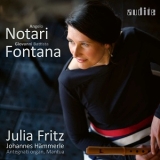An den Ursprungsort der Werke haben sich die Beteiligten dieser Aufnahme begeben, um in der Kirche Santa Barbara des herzoglichen Palasts in Mantua diese einzuspielen. Dabei konnten sie diesen als idealen Platz nutzen. Die Orgel der Kirche Santa Barbara aus dem 16. Jahrhundert bietet sich dank spezieller Register und mitteltöniger Stimmung nicht nur für Solostücke, sondern auch für die Begleitung von Ensembles an.
Die beiden Komponisten, Fontana und Notari, Zeitgenossen von Monteverdi, kommen hier mit verschiedenen musikalischen Werken zu Gehör. Die frühbarocken Violinsonaten des Giovanni Battista Fontana hat Julia Fritz mit der Continuo Gruppe für diverse Blockflöten umgesetzt. Angelo Notari dagegen wird mit Liedern gezeigt, die bearbeitet oder variiert erklingen. Diese Lieder, zum Teil in Ersteinspielungen, zeigen das hohe Niveau der Solo- und Verzierungskunst. Die Sopranistin Magdalene Harer übernimmt hier die Gesangsstimme.
Die sechs Violinsonaten von Fontana mit Generalbassbegleitung mit jeweils einer Flöte als Instrument der Solostimme erleben in der Interpretation von Julia Fritz eine so engagierte und makellose Widergabe, dass man die Violine als Soloinstrument nicht vermisst, sondern diese Lesart einfach genießt. Die Blockflötenfamilie wird oft geschmäht. Aber das ist dann immer mit dem Höreindruck verbunden, der sich beim Spiel von Kindern auf ihren ersten Schritten in die Musik eingeprägt hat. Wird dieses Instrument jedoch von jemandem wie Julia Fritz an die Lippen gesetzt, die es meisterhaft versteht, der Flöte nicht nur Töne zu entlocken, sondern diese zu modellieren, wird auch die Musik mit Blockflöte zu einem Erlebnis.
Magdalene Harer lässt die Arias mit ihrer hellen und klaren Stimme erblühen, Dabei gelingt es ihr, ihre besondere Stellung in der Musik hervorzuheben, ohne ihre Begleiter zuzudecken. Mit feiner und gut artikulierender Stimme prägt sie die Stücke angenehm und reizt damit, diesen Komponisten noch besser zu erkunden.
Reinhild Waldek für das Harfenspiel und Johannes Hämmerle an der Orgel sind eine Continuo Formation, wie man sie nicht alle Tage zu hören bekommt. Sie geben mit ihrem gelungenen Einsatz eine weitere klangliche Note, die das Gesamtpaket positiv komplettiert.
The participants of this recording went to the place where the works were first played and recorded them at the church of Santa Barbara in the ducal palace of Mantua, an ideal place. , Thanks to its special stops and mid-tone tuning, the organ of the church of Santa Barbara, dating from the 16th century, is used not only for the solo pieces, but also for the accompaniment of ensembles
The two composers, Fontana and Notari, contemporaries of Monteverdi, are heard here with various musical works. The early baroque violin sonatas of Giovanni Battista Fontana have been transposed by Julia Fritz with the continuo group for various recorders. Angelo Notari, on the other hand, is featured with songs. These songs, partly in first recordings, show the high level of solo and ornamentation art. Soprano Magdalene Harer takes the vocal part here.
The six violin sonatas by Fontana with basso continuo accompaniment, each with a flute as the instrument of the solo part, experience such a committed and flawless performance with Julia Fritz that one does not miss the violin as a solo instrument, but simply enjoys this interpretation. The recorder family is often reviled. But then, this is always connected with the impression that is imprinted on the playing of children on their first steps into music. However, when this instrument is put to the lips of someone like Julia Fritz, who is a master at not only eliciting tones from the flute, but modeling them, music with recorder also becomes a rewarding experience.
Magdalene Harer makes the arias blossom with her bright and clear voice, managing to emphasize their special place in the music without covering up her accompanists. With a fine and well-articulated voice, she makes a pleasant mark on the pieces and thus encourages us to explore this composer even more.
Reinhild Waldek for the harp and Johannes Hämmerle on the organ are a continuo formation that one does not hear every day. With their successful efforts, they add another sonic touch that positively completes the overall package.
























